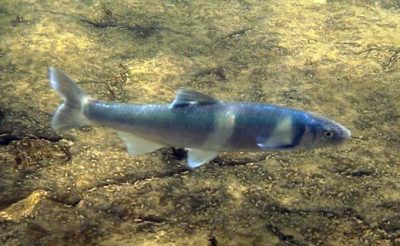October 18, 2018

Thousands of small, shiny fish are making their way from rivers to smaller creeks this time of year, and biologists are determined to find out why.
In order to gain a better understanding of what triggers this annual migration, Mainspring Conservation Trust is collaborating with Tennessee Valley Authority (TVA) on a project to study these minnows. Mainspring’s biologists are also analyzing what creeks or habitats the fish are searching for and how long they remain in the creeks after then find them – before swimming back to the rivers.
Shiners and minnows can be found almost anywhere, but many of the minnows in western North Carolina prefer free-flowing waters instead of the standing water found in lakes. The type of free-flowing water matters too; some species of shiners prefer small creeks while others prefer larger rivers. However, in the fall, there is a mass migration of the river shiners into the smaller creeks. The federally Threatened spotfin chub is one of the species that have been documented to move from larger rivers into small creeks each fall.
In creeks where shiners have been observed before, Mainspring’s biologists are currently surveying every week to determine when this migration starts. Although it varies slightly from year to year, the week of October 8th marked the first indication that the migration had started for 2018, when Whitetail shiners, found mostly in the river, began to outnumber Warpaint shiners, a creek dweller.
Why are shiners important? Anglers are well aware these shiners make up a large part of the diet of our gamefish such as bass, catfish, and walleye. Lots of shiners mean more biodiversity and more and larger fish to catch for all anglers – both locals and tourists.
What can you do to help with their migration? Fish move to small streams for reasons we do not understand, but rarely does any species do something without purpose. Small streams are often the most neglected, and, while they are always ecologically important, they are even more so during certain times of the year. Shading your stream and providing alternative watering sources for livestock are just two ways to take care of what you may consider an insignificant little branch. That’s important because that branch may, in part, play a role in the life of the fish that you or your loved one may catch on the river next summer, or in the life of the one that got away.
Dedicated to saving the nationally significant places in the Southern Blue Ridge, Mainspring Conservation Trust serves the six western-most counties in North Carolina and northern Rabun County, Georgia. Learn more at www.mainspringconserves.org.

